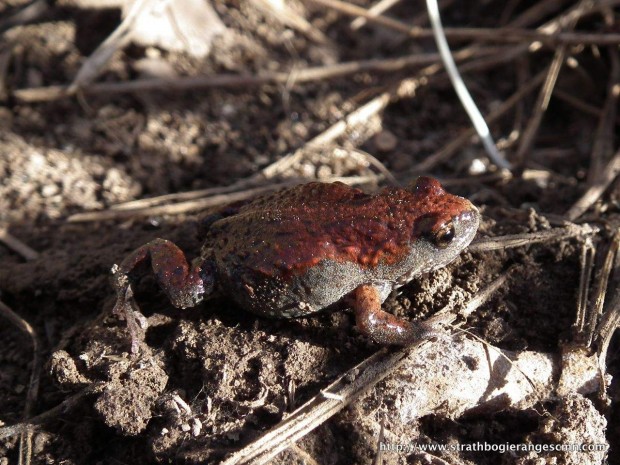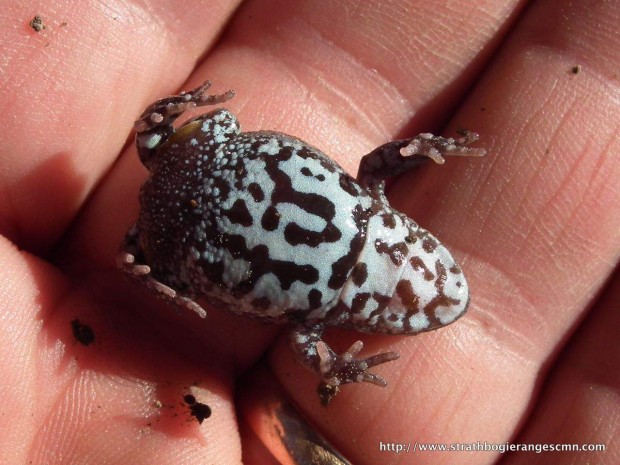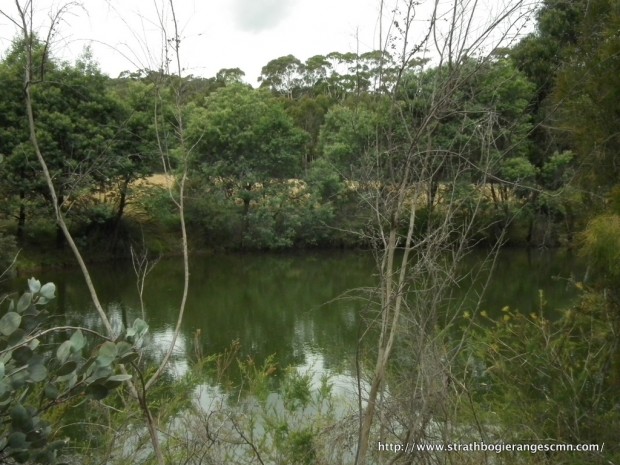Improving and protecting local wetland habitat
… will be the focus of a new project in the Strathbogie Ranges CMN area. The districts of Swanpool, Warrenbayne, Boho and Euroa will be the primary focus of this 2-year $137,000 project.
The main project partners include:
– Strathbogie Ranges CMN
– Warrenbayne-Boho & Swanpool Landcare
– Gecko Landcare Network
– Euroa Arboretum Indigenous Nursery & Seed Bank
– GBCMA
And there’s the opportunity to include other groups, where appropriate.
A short summary of the project’s focus, objectives, actions and benefits
Total funding 2012-14 = $137,355
Local issues being addressed:

The project will target habitat for threatened frog species and enhance and protect biodiversity hotspots in farming landscapes within the ‘woodland zone’ of the northern Strathbogie Ranges. Two threatened frogs, Growling Grass Frog (Litoria raniformis) and Bibron’s Toadlet (Pseudophryne bibroni), have fragmented distributions in this landscape. Many species of waterbird, particularly migratory species such as Musk Duck, Australasian Bittern, Nankeen Night-heron, Hardhead Duck, Latham’s Snipe, and Rail and Crake species also occur here.
Reason for addressing the issue:

Remnant woodlands and their natural wetland components are highly diminished and often highly modified in this landscape. Landholder communities are aware both of the threats and opportunities to secure/build biodiversity assets using farm dams as a starting point. Securing fenced (stock-proof), revegetated farm dams with shallow and deep water components, is central to the conservation of wetland biodiversity.
Anticipated environmental & community benefits
(1) Improved wetland habitat for several threatened species (frogs & birds) and a wide range of wetland fauna. (2) Improved habitat connectivity within threatened woodland ecosystems. (3) Vastly improved wetland fauna database in the project area. (4) Improved community skills, knowledge and empowerment. (5) Demonstrating multiple benefits from ecologically healthy farm wetlands
Project objectives
(1) Determine the species distribution (by landholders audio recording frog choruses) of all local frog species, including two threatened species. (2). Engage and empower local communities by delivering a variety of community activities and developing & distributing wetland educational material. (3) Identify and promote 3 local, best practice demonstration sites of farm-dam-to-wetland transformation and follow-up with cost-share funding for at least 12 other landholders to convert farm dams into farm wetlands. (4) Share and archive all project information, results and insights via project website.
What is being protected or restored?

The project targets artificial and degraded natural wetland sites in threatened woodland EVC’s, for example: Creekline Grassy Woodland, Plains Woodland, Plains Grassy Woodland, Grassy Woodland. The target species are wetland dependent species of frogs & birds, particularly the Growling Grass Frog and Bibron’s Toadlet, and several species of rails and crakes.
Actions
- Control 2 ha of Blackberry, St John’s Wort, Sweet Reed Grass around wetlands and associated streams.
- Improve/clean-up approx. 1 km or waterway/wetland- improve water quality and replace logs in streams/wetlands.
- 5 ha (1500 plants) of indigenous revegetation, including fencing.
- Assess and protect (fence) 15 ha of native wetland/woodland vegetation.
- Prepare & distribute project advertising & educational material.
- Collect wetland biodiversity information (frog & bird species), build a local wetland database and submit records to Vict. Biodiversity Atlas.
What will be achieved by the project?
(1) Creation of best practice examples of local on-farm, biodiverse wetlands. (2) Local communities and landholders collective learning about principles and practice of the benefits of on-farm wetlands. (3) Enhancement and protection of critical wetland habitat for two threatened frog species and several threatened water birds. (4) Community driven fauna surveys that benchmark frog and waterbird distributions in the project area. (5) All project material and results will be shared and archived via a project website.
How will the project engage volunteers?
Year 1: volunteers will help plan and deliver a range of community activities (Total 15 people). Participants will visit existing, local farm wetlands and either Wonga Wetlands/Albury, or National Envt Centre wetlands/Thurgoona, Albury for training and inspiration (total 40). Volunteers will undertake community fauna surveying (frogs and waterbirds) throughout Yrs 1 & 2 (Swanpool 15, W-B 15, Euroa 20) Year 2: similar numbers .
How will the project build skills and knowledge in the local community?
Experts will provide training and guidance on design and construction. Local project coordinators will work closely with landholders and community- keeping learning local. Visits to high quality existing constructed wetlands (local and regional) will develop vision and imagination. Project participants will have access to wetland construction design principles, case studies and all project results.
B. Lobert 20.4.12
